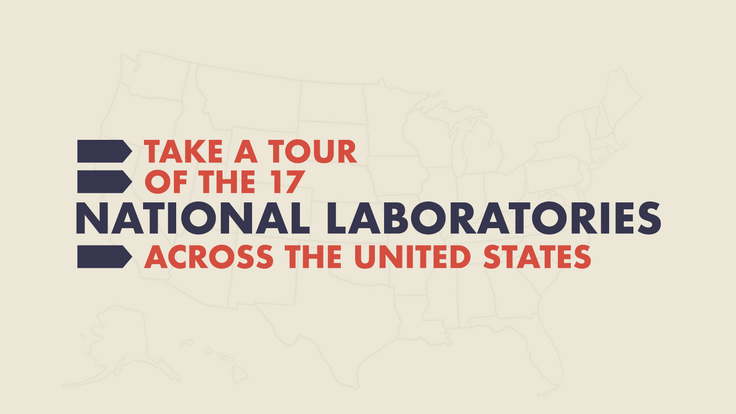Close Quarters
By Dave Mosher
During their stays at other labs, physicists learn that it's a small world after all.
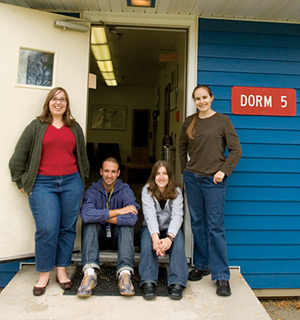 |
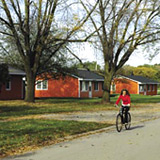 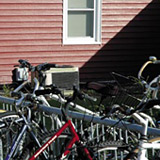 |
|
Photos: Sandbox Studio |
|
A little after midnight, foreign voices and scents of dinner drift from the kitchen and down the halls of Dorm 1. Slavic dialogue stirs me from sleep and the aroma of cooked kielbasa sausage grabs my full attention. As my eyes adjust to the darkness, the monotone surroundings of a Fermilab dorm room begin to materialize: a small desk, a slender dresser, a quaint painting of a Native American pot. The room is dull. It's cramped. And the bed is really, really small.
As a summer intern in Fermilab's Office of Public Affairs, I slept, ate, worked, and played in the same spaces as scientists. Although my stay may have been short, it presented convenient and unique opportunities to learn and write about high-energy particle physics.
But for scientists staying for a few weeks, months, or sometimes years at a time, living on-site is much more than a convenience–it is a boon to their inquiry-driven lifestyles. Every particle physics laboratory makes room for visiting scientists from around the world, and almost all particle physicists need a home away from home on a regular basis. Accommodations tend toward the austere, but then so do the lifestyles of physicist travelers.
No-frills necessities
Working under tight budgets, scientists appreciate affordable dorms, apartments, and guest houses–temporary but comfortable homes that bring the world's best and brightest together under one roof. "No frills" is a response as common as an electron if you ask residents about their abodes.
"Many of the rooms don't even have an alarm clock," says Tom Peterson of Fermilab. "I have to remember to take one with me. More than once I've asked my colleagues to wake me up by pounding on the door because I forgot it."
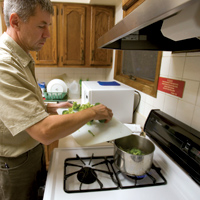 |
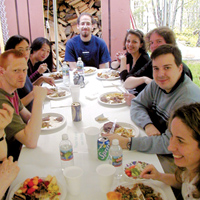 |
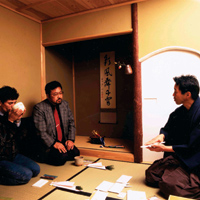 |
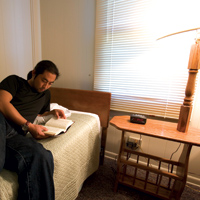 |
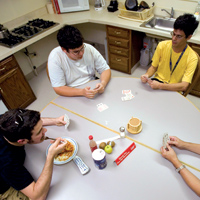 |
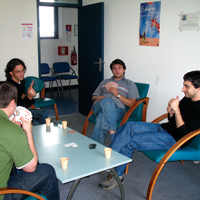 |
|
Photos: Fermilab (3), MINOS Collaboration (1), KEK (1), IN2P3 (1) |
|
During his ongoing 30-year career, the engineer with peppery-gray hair has stayed at labs across the globe. Peterson finds the quarters close and the rooms drab, but he insists scientists aren't looking for a Hilton, much less a motel. "Physicists just need a convenient place to crash," he says.
“You really can't work in a focused way if you're distracted by amenities.”
Fermilab's Marc Ross finds having a bed nearby helps keep him on task. "You really can't work in a focused way if you're distracted by amenities," he says. While often more spacious, off-site vacancies frequently lack the convenience of on-site accommodations, which provide residents with fully-equipped kitchens, TV lounge areas, laundry facilities, furnished rooms and–most importantly–a short walk to work for a fraction of a motel room price tag. "Everything you need is less than a mile from your room," Ross says about the on-site guest houses at various laboratories around the world that he has stayed at.
A bed close to the workplace is even more sacred to guests who defy normal circadian rhythms by working on round-the-clock experiments. For these physicists, sleeping through most of the day and arriving at work around 11 p.m. is nothing out of the ordinary. "It's not what a typical business traveler is used to," Peterson says.
Roommates' schedules can be so contrasting that it's common for a guest not to see fellow residents for almost a week or, in extreme cases, never meet them at all. "When I stayed at DESY in Germany, there was one other resident on the living room couch during the evenings. When I came in, I always saw him sleeping," Peterson says laughing, "but I never actually met him."
Even if guests are more like ghosts to one another, most find a way to introduce themselves. As a Japanese postdoc at Fermilab, Hidekazu Tanaka says working from 8 a.m. to 11 p.m. prevented him from meeting residents in his dorm–until a severe thunderstorm rolled through the site. "There's an alarm box in my room and it started screaming at five in the morning," he says. "I saw all the people in the dorm coming out of their rooms and asking each other, What is going on?'"
Confusing surprises also lie in wait at other labs. At DESY in Germany, refrigerators are compartmentalized and locked up to keep things tidy. Remembering the key to unlock food from chilly cubbyholes can be frustrating, says Barbara Warmbein, an International Linear Collider communicator at DESY. But food isn't the only thing incarcerated at the lab. "The TV and VCR are behind glass so people won't take them. When you want to change channels, you have to get up and stick your fingers into little holes in the glass," she says. "It's a little annoying."
Feeding international collaboration
Besides work, scientists have to eat, making the on-site kitchen a prime place to bump into other members of the high-energy physics community. Among the clanking of dishes and pans, it's not unusual to hear three different conversations in three different languages going at once. "In KEK dorms around 6 p.m., everyone is in the kitchen stir-frying dinner in a wok," says Alan Schwartz, a University of Cincinnati physicist working in Japan. "If anyone hangs out in the dorms, it's usually in the kitchen."
Schwartz, who is working on the Belle experiment at KEK, says there is an important aspect when it comes to scientists simply hanging out together. "When they get together, they talk about science and share their ideas," he says, "so having common areas where people can chat is important."
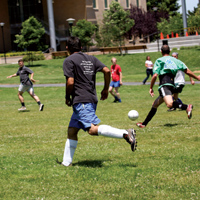 |
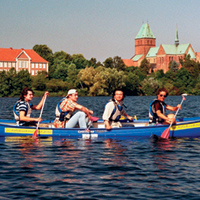 |
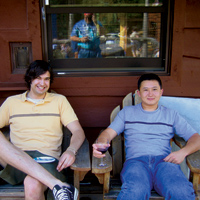 |
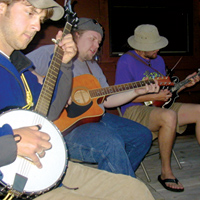 |
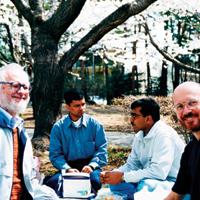 |
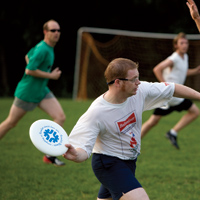 |
|
Photos: SLAC (1), DESY (1), MINOS Collaboration (2), KEK (1), Fermilab (1) |
|
“If anyone hangs out in the dorms, it's usually in the kitchen.”
Because dorms mostly lack appealing spaces and residents can get bored hiding away in bedrooms, cafeterias at labs across the globe are hot spots for networking and sharing ideas. "But what you talk about in a cafeteria depends enormously on who you're sitting with," says Nan Phinney, an accelerator physicist at Stanford Linear Accelerator Center. "If you're there for a two-day meeting, it's probably going to be conversation about Science with a big S," she says, "and you sort of continue working but in a more relaxed fashion."
During lunch in lab cafeterias, Warmbein often sees conversing physicists hash out concepts on the closest writing material they can find. "Napkins are a sought-after thing for scribbling on and exchanging ideas," she says. "It seems like physicists are always talking about science over lunch."
Still, physics isn't always on the minds of scientists during a meal. "During the winter at CERN, you can't sit down without someone talking about skiing," Phinney says. If she bumps into long-lost friends while visiting a lab, Phinney says the conversation is more natural and light-hearted. "Whenever I go to a lab for a big conference, I'll see people I haven't seen in a long time and it's a big pleasure," she says. "Sitting with your friends is quite a lot of fun."
For Peterson, meeting up with his buddies for a bite to eat is a major highlight during trips. "Conversing over meals with colleagues is often the most enjoyable part of my visit," he says. "I think it helps foster better communication." Peterson can't say for sure why, but he's found that people respond more quickly to emails and phone calls when they know the person on the other end of the line. "Dining together really makes the business of communicating easier," he says.
But meals aren't required to create important communication opportunities–simply grabbing a drink is a great excuse to chat. At Fermilab, workers meet over a drink and share laughs at the Users' Center while coffee breaks in the cafeteria are a favorite among physicists at CERN. "A standing joke about CERN is that if someone goes to the office looking for a colleague and they're not there, they're in the cafeteria having coffee," says Christoph Paus of CERN. "People love the cafeteria."

Kicking back or kicking a ball
Labs may provide appealing spaces for discussing new ideas in physics or simply the latest gossip, but they also welcome on-site sports and clubs to help scientists kick back. From soccer, baseball, golf, and ultimate Frisbee leagues to rock and jazz bands, folk dancing, and model airplane clubs, something to do after work is just around the corner.
When it's warm outside, soccer fever brings a lot of scientific visitors to the turf. "I love to play soccer at Fermilab, but the mosquitoes are really annoying," says Ulrich Nierste, a theorist from Germany's University of Karlsruhe. But in a way, Nierste doesn't mind the itchy critters. "They keep you running very fast," he says.
For Nierste, however, soccer isn't just for kicks. "Having sports is very important for a lab because you get to do something with colleagues that isn't work," he says. Just like working together on an experiment, time on the field helps build long-lasting friendships and close networks among labs across the planet. "Physicists move a lot [from one work place to the next] and we're pretty mixed up," Nierste says. "But in a way, it's like being part of one big family."
When Giulia Zanderighi stayed at Fermilab, she wasn't looking to break a sweat on the volleyball court. "But someone suggested I could play and I really got into it," she says. The CERN theorist's favorite matches took place on Wednesday afternoons, when theorists faced off with experimentalists. "I made quite a few friendships through it," she says. "I sometimes see players at CERN; it makes the world smaller."
All of the amenities that make on-site life tick–including the cramped housing, common eating areas, and after-work clubs–strongly remind Peterson of a university environment. "I think all of the labs have tried to create a collegiate atmosphere," he says. "There's something about it that helps foster collaborative efforts."
Collaboration and collegiality can go too far, however. The college dorm tradition of "borrowing" food is honored around the world, as I learned one night when my sequestered kielbasa sausage went missing. I told myself it was for the good of science.
Click here to download the pdf version of this article.





